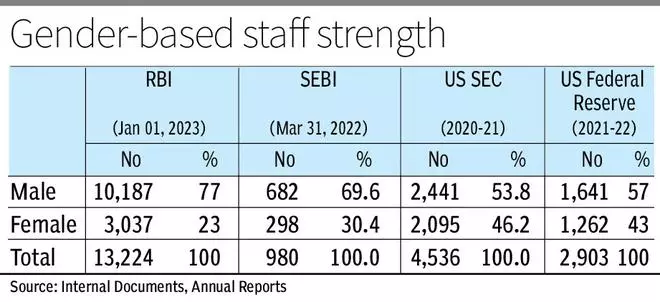Gender parity in staff strength of the top two regulators in India – Reserve Bank of India and Securities and Exchange Board of India (SEBI) – is yet to find a place. Three-fourth of the employees at RBI are males, while at SEBI, the proportion is more than two-third.
In comparison, SEBI’s counterpart in the US, the Securities and Exchange Commission), and RBI’s counterpart, the Federal Reserve, have a gender ratio of almost 1:1.
BusinessLine sent a detailed e-mail to both RBI and SEBI to get their views on skewed ratio, but despite repeated requests, did not get any response.
The RBI annual report gives number of total staff cadre wise (Class I, III and IV) and category wise (SC, ST and OBC), but not according to gender. However, an internal document assessed by businessline showed that as on January 1, 2023, of the total staff strength of over 13000, only 23 per cent are females.

Among the key officials, RBI has just one female each in Central Board of Directors and in the group of 16 Executive Directors. Among 30 Chief General Managers, there are 10 females. It may be noted that since the inception in 1935, the RBI is yet to see a female governor. At the same time, of the 64 Deputy Governors appointed between 1935 and till date, only three females got the coveted post.
Governors, Deputy Governors and Members to the Central Board are appointed by the Government. In the list of General Manager empanelled as Chief General Managers, out of 29 from general side only 5 females were considered for the post.
Low female participations in key managerial positions has also affected RBI’s ranking in OMFIF GBI (GENDER BALANCE INDEX) 2022 where it is placed at 149 out of 159 ranks. Only central banks of China and Korea are placed below RBI. OMFIF (Official Monetary and Financial Institutions Forum) is an independent forum for central banking, economic policy and public investment. The GBI, now in its ninth year, tracks the number of senior positions held by women at central banks, public pension funds, sovereign funds and commercial banks.
Annual report of SEBI was clearer in giving details about staff strength. According to 2020-21 edition of the report, as on March 31, 2022, the total number of employees across various grades is 980 (including employees on deputation/ contract). Of these, 905 employees are officers and 75 employees comprise secretaries and other staff. “The male and female composition is 682 and 298, respectively,” it said.
It may be noted that SEBI is currently headed by a woman – Madhabi Puri Buch. She is the first female chairperson. She also has the credit of only female Whole Time Member till date. Chairperson and Whole Time Members are appointed by the Government.
Among key officials here, the situation is not vastly different from RBI. According to the SEBI Annual Report, as on March 31, 2022, there were just one female Executive Directors among 10 such officers. Also, out of 40 CGM level officers, number of female officers was just 7.
Analysing the trend, Rajneesh Singh, Managing Partner at SimplyHR Solutions says through female participation in labour force has gone up, their share in overall job scenario is yet to pick up. “One reason could be absence of law, rules or regulations or lack of equal opportunity type framework of US, another reason could be matrimonial and family issues. Post marriage and post family building, managing a full time job is not that easy,“ he said.
Meanwhile, both the regulators can take comfort from the fact that In FY 2021-22, women constituted just 9 per cent of total employees in Cental Public Sector Enterprises (CPSEs)





Comments
Comments have to be in English, and in full sentences. They cannot be abusive or personal. Please abide by our community guidelines for posting your comments.
We have migrated to a new commenting platform. If you are already a registered user of TheHindu Businessline and logged in, you may continue to engage with our articles. If you do not have an account please register and login to post comments. Users can access their older comments by logging into their accounts on Vuukle.